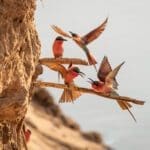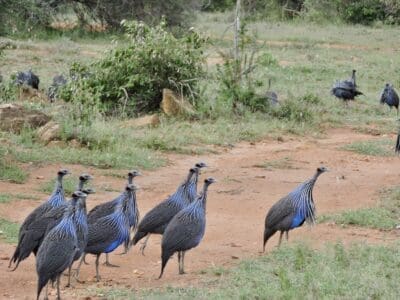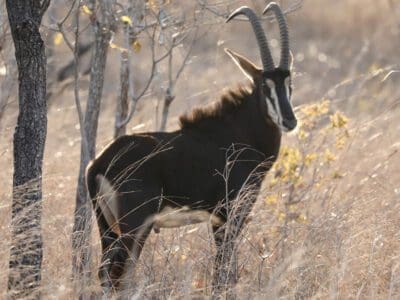On an African safari, seeing the Big Five game animals ranks highly on most people’s lists. A term originally coined by big-game hunters, the Big Five are said to be the most dangerous African animals to hunt on foot. However, this term is now used to talk about five of the most popular African animals. Let’s find out what the Big Five consists of and the best locations to see them at.
Which Animals Make Up the Big Five?
The five African animals collectively known as the Big Five are:
- The African Elephant (Loxodonta africana). This is the world’s largest and heaviest land animal. It is found throughout Africa and within a range of habitats, including both wetlands and deserts. Herds are led by an older matriarch and are made up of mothers with their babies and other female relatives. Male elephants will leave the herd when they reach puberty at around 14 years of age and are often seen on their own or with a loose-knit bachelor herd.
- The African Leopard (Panthera pardus). One of the hardest to find, the leopard is naturally shy and generally spends its days hidden from view, often in bushes and trees along river banks. They are very strong and climb trees to store their fresh kills away from other predators, as well as a lookout to spot prey.
- Cape Buffalo (Syncerus caffer). Cape buffalo are found throughout sub-Saharan Africa in areas which have an abundance of water as they need to drink every day. There are four subspecies of Cape buffalo, with East and Southern African being home to the largest herds. While herds are generally placid, lone males are considered one of the most dangerous animals due to their unpredictable and temperamental behaviour. Cape buffalo are indigenous to Africa, in contrast to Water buffalo which are found in Asia.
- The African lion (Panthera leo). The world’s second largest cat after the tiger, the African lion is known as the king of the sub-Saharan savannah. They are usually more active at night, preferring to sleep for up to 20 hours per day! Unlike leopards and cheetahs, lions are social animals and live in prides. Females are the primary hunters in the pride and often use teamwork to catch their prey.
- African rhinos; the black rhino (Diceros bicornis) and the white rhino (Ceratotherium simum). African rhinos are Critically Endangered and at risk of extinction. While poaching for their horn is a major reason for their decline they also face threats from habitat loss and political conflict. It is estimated that there are only 20,000 white and 5,000 black rhino left in the wild. Rhinos have poor eye sight, but exceptional hearing and sense of smell.
Where Are the Best Places to See the Big Five?
Before you head away on your African safari, although it would be fantastic to see all five of these African animals, there are no guarantees in nature. What you can do though is choose a safari which visits the location where they are most likely to be found. This includes:
- South Africa: Kruger National Park & Private Reserves, Eastern Cape & Madikwe
- Botswana – Chobe National Park & Okavango Delta/Moremi Game Reserve
- Kenya – Masai Mara, Ol Pejeta in northern Kenya
- Tanzania – Ngorongoro Crater, Serengeti National Park
If there are specific African animals you would like to see, contact your safari operator before you book. Having lived in Kenya and travelled throughout Africa for many years, we have the insider knowledge on the best spots to visit, including private concessions and conservancies where you can view wildlife away from the crowds in the National Parks! Which of the Big Five would you love to see? Let us know today and we’ll point you in the right direction of the best African safari for you to book.





